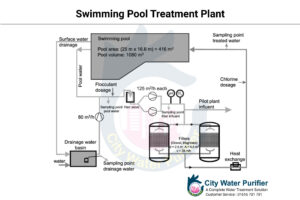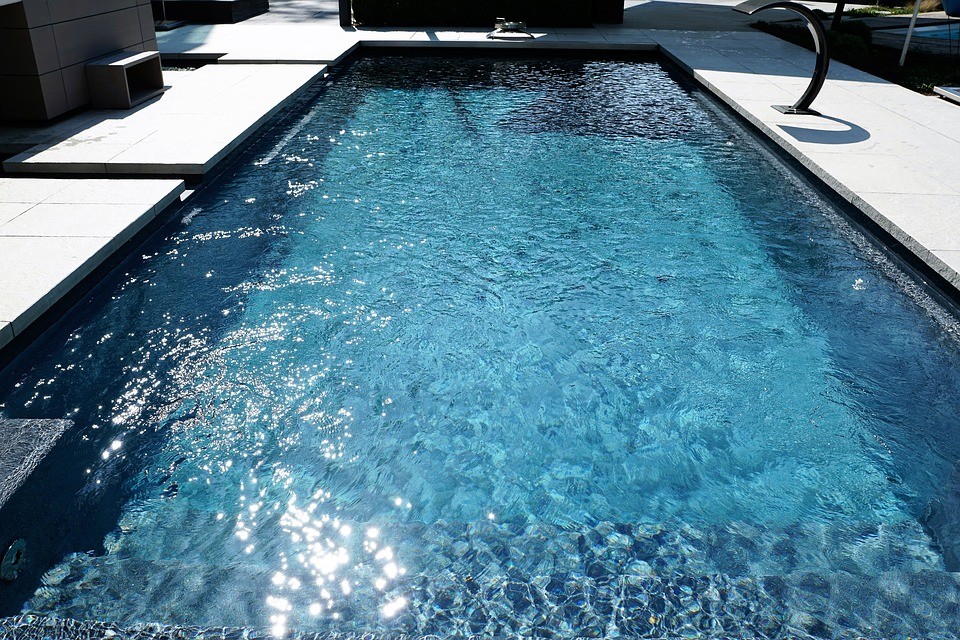A swimming pool water treatment plant will improve your water filtering options. This is a technique for removing a substantial amount of pollution from water by forcing it through a semipermeable membrane under high pressure. The best option to produce outstanding safe water for personal and business use is to install a swimming pool water treatment system.
It prevents water from evaporating, and it uses less energy while controlling water loss. To install, the user simply requires a modest amount of space. a water treatment system for swimming pools the equipment is small and compact, therefore it saves a lot of space.
It is simple and convenient to clean the swimming pool water treatment plant. This method eliminates pollutants and impurities without collecting them. There are no purifying chemicals required at the swimming pool water treatment plant. It’s fully green and environmentally friendly. The filtration system saves both electricity and money.
Every day, a swimming pool water treatment plant filters vast amounts of water while consuming little electricity. It’s easy to maintain, and it’s also inexpensive.
Swimming is a popular year-round activity enjoyed by more than 250 – 300 million people in Germany each year for leisure, recreation, and exercise. The United States has recorded comparable numbers of annual visitors (368 million people).
Swimming is ranked second among the most popular recreational sports in Germany, only behind cycling, according to a survey done in 2001. These findings are consistent with data from the United Kingdom and the United States.
Swimming is well accepted in the populace, resulting in a large number of public and private pool facilities. In the year 2012, the total number of public pools in Germany was predicted to be 7.499 (excluding natural pools, counting combined indoor-outdoor pools twice). In the year 2002, comparable pool counts were recorded for Germany.
France (1.466.000), Spain (1.200.000), and Germany (1.466.000) have the most in-ground and above-ground pools in Europe, including private pool facilities.
Types of swimming pools
Swimming pools come in a variety of shapes and sizes. The function (tropical swimming pool, sauna), size, and circumstances (water temperature, cleaning system, and water disinfection method) of swimming pools vary. Swimming pools can be divided into indoor and outdoor pools.
There is a distinction to be made between swimming pools that have a water recirculation system and swimming pools that are constantly refreshed with water. The water in circulation pools is recirculated from a water purifying system. After treatment, a portion of the water is removed and taken away. Freshwater will be added to the pool.
The water in a swimming pool that has a constant flow is constantly refreshed. The retreating pool water is either released into the sewer system or transported to a water purifying plant. Water recirculation is used in most public pools.
Swimming Pool Water Treatment in Bangladesh
Swimming pool water must be treated to keep it clear and clean, free of dangerous compounds, bacteria, viruses, algae, and other diseases, and safe for swimmers to use.
Purification steps
Various purifying steps are used to treat swimming pool water. Swimming pool water is initially transferred to a water treatment plant. It will pass through a hair removal filter at the water purification facility, which removes raw pollutions like hairs, plasters, and leaves from the water.
Causing smaller colloids to bond together. Colloids are visible floating organic matter particles such as skin tissue and fibers. Colloidal contaminants, such as saliva, soap residues, cosmetics, and skin lipids, are included in this category. Turbidity is caused by an abundance of these contaminants.
Water turbidity and potassium permanganate (KMnO4) requirement are two indicators of the presence of undissolved particles. Potassium permanganate is used as a marker for the oxidation of organic materials.
A sand filter removes floating particles from water. The sand filter is backflushed on a regular basis. Pollutants are then dumped into the sewer system.
Swimming Pool Water Treatment Processes
Understanding the fundamentals of swimming pool water treatment is crucial for the people’s health if you already own or plan to acquire a swimming pool. In other words, the water circulation system is an internally connected system that circulates water from the pool until it returns to the pool. This process involves the pool passing through a collection or storage tank, a water circulation pump, filters, a chemical treatment unit, and water heaters, if any are used.
Key Phrases about Swimming Pool Water Treatment Systems
Water treatment
This procedure involves adding chemicals to the water and using filtration devices to filter and sterilize swimming pool water.
Cycle time
Represents the amount of time (in hours) needed to bring the water volume up to the pool’s capacity.
Regularity coefficient
It is the ratio of the theoretical sieve size (in millimeters) that could pass 60% of the sand to the theoretical sieve size (in millimeters) that could pass 10%.
The Waterline
One of the following methods must be used to determine the water line:
- Skimming system: Water line must be in the center of the scraper’s operating range for the skimming system to function.
- Overflow drainage system: The water line ought to be situated at the flood limit’s uppermost point.
Basic water treatment devices for swimming pools
A separate water circulation and treatment system that is designed to continually circulate, filter, and sterilize the pool water must be installed in every swimming pool.
Pumps, chemical feeders, skimmers or surrounding systems for the release of surplus water, various kinds of water valves, pipelines, connectors, fittings, and accessories make up the system. The system’s noise level must never be more than 45 decibels (dBA).
The pump
To keep the water clean and hot, the pump pumps it through the filter (or filters) and the water heater. At least once every two hours, the pool pump should be able to move the water around.
The filter
The filter must be able to maintain the water’s cleanliness by eliminating sediments, algae, and dirt. Cartridge filters, diatomaceous earth filters, and sand filters are the three main categories of filters.
Water Heaters
The majority of water heaters are powered by electric fuels, solar heating, or fossil fuels like natural gas, propane, or petroleum heating.
Important Advice for Keeping your Pool Clean
- Every day, the water’s pH should be measured.
- Particularly for heated pools, be aware of the amount of chlorine in the water. Compared to conventional, unheated pools, heated pools require a higher concentration of chlorine.
- Every day, the pool water should be cleaned and all filth should be removed using the abrasive net.
- For the water filter to effectively remove dirt from the pool water and avoid collecting dust and debris, it needs to be inspected and cleaned. To keep the water clean and clear of deposits from the pool’s bottom, make sure to run the water filter every day.
- The amount of chlorine present in the pool water must be guaranteed.
- The equipment, including the water pump, should be inspected on a regular basis.
- If the pool has a filter, water pressure must be used to clean every surface.
- The sand filter should be cleaned from the back.
- The pool is fully drained of water if the residence is left unattended for more than twenty-four hours, and it is thoroughly cleaned before being filled with water again.
- Because they have original spare parts, maintenance companies that specialize in swimming pool maintenance should replace or repair damaged parts as soon as possible.
Swimming Pool Filtration Plant

Swimming Pool Filtration Plants are one of our most well-known products. They’re used to keep the pool’s chlorine and PH levels in check, ensuring that bacteria and algae are killed and the pool is biologically safe.
The filtering media filters out particle matter, sediments, and trash from the pool water, allowing clear water to return to the pool. We provide a variety of AST filtering plants made of mild steel to remove various sorts of dirt.
Features:
- Multiple models available
- Easy to install
- User-friendly operation
A clean pool, both visually and biologically, is one that has been properly maintained. Bacteria and algae will be eliminated and the pool will be biologically safe if the chlorine and PH levels are maintained. Filtration is a mechanical method for eliminating insoluble materials from pool water.
Filtering medium removes particle matter, sediments, and trash from pool water, allowing clear water to return to the pool. The clarity of the water is vital for aesthetics, cleanliness, and safety.
Impurities, both dissolved and undissolved, are naturally present in water. Filtration is a common and basic procedure for removing undissolved contaminants in water and precipitate sludge. Various types of AST filtering facilities are available to remove various types of contaminants at various flow rates.
AST filters are pressure-operated filters made of mild steel/FRP closed vessels with frontal pipes supplied with valves. Water is filtered via various grades of filter media, with undesired contaminants being left behind at the filter bed.
Backflushing is an arrangement in which the deposited impurity at the filter bed is readily flushed away to clean the filter bed, and so the reverse flow of water washes away the pollutants deposited at the filter bed.
From civil construction to mechanical and hydraulic considerations, all swimming pool designs are suitable with Ozonation. We have established scientific optimization, integration, and customization techniques over a lengthy period of time. High quality, performance, and aesthetic value are provided by an architecturally planned pool with scientific and strategically developed civil, hydraulic, and water treatment plant design.
A swimming pool water treatment plant will improve your water filtering options. This is a technique for removing a substantial amount of pollution from water by forcing it through a semipermeable membrane under high pressure. The best option to produce outstanding safe water for personal and business use is to install a swimming pool water treatment system.
City Water Purifier has the greatest swimming pool water treatment plant for your residential and commercial water treatment needs. Because it creates fresh, pleasant water, this system encourages hydration.
The best safe drinking water is provided by a swimming pool water treatment plant, which lowers your exposure to toxins. This system filters out germs and pollutants, resulting in water that tastes great and is crystal clear. Energy-saving separation techniques are used in the swimming pool water treatment facility.

